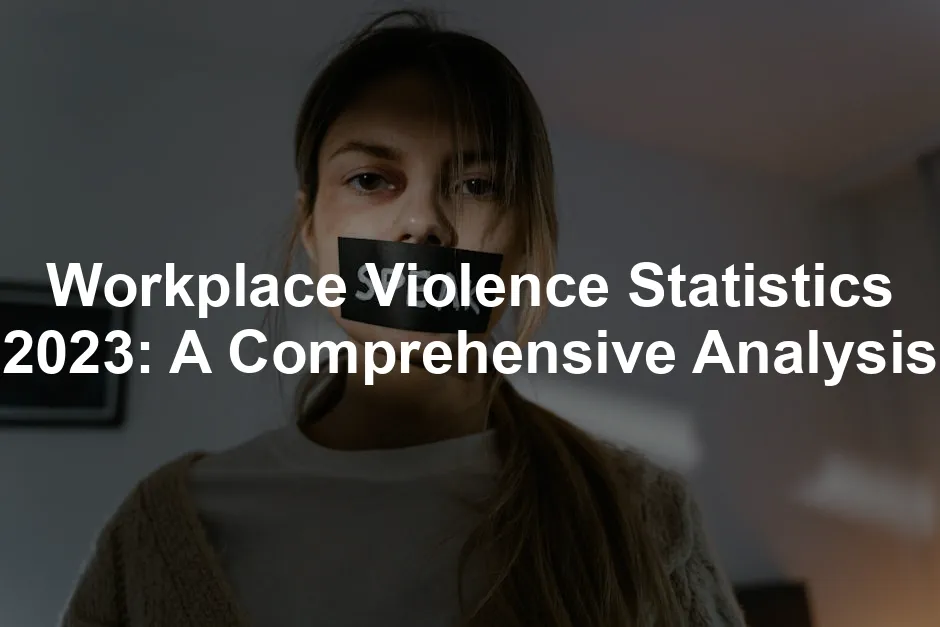Introduction
Workplace violence is a serious issue affecting employees across the globe. It encompasses various forms of violence, including physical assaults, verbal threats, and psychological abuse. Each type poses unique challenges and can significantly impact workplace culture and employee well-being.
Understanding workplace violence is crucial for several reasons. Firstly, it helps organizations identify potential risks and implement effective prevention strategies. Secondly, it raises awareness about the prevalence of these incidents, ensuring that employees feel safe and supported. Lastly, workplace violence statistics guide policymakers in creating regulations that protect workers and promote a healthier work environment.
In this article, we will explore the latest workplace violence statistics for 2023. You can expect to learn about the prevalence of workplace violence, the demographics of victims, and the most affected industries. By delving into these statistics, we aim to shed light on this alarming issue and encourage employers to take action.

Current Workplace Violence Statistics
General Statistics
Workplace violence is alarmingly common. Reports indicate that 23% of employees worldwide have faced some form of workplace violence. This statistic emphasizes that violence is not just an isolated issue; it affects millions of workers globally. In the United States, approximately 2 million individuals experience nonfatal workplace injuries annually. These incidents range from minor scuffles to severe assaults, with many cases going unreported.
Fatalities due to workplace violence have also seen a troubling increase. In 2020, the number of workplace homicides reached 392, rising to 481 in 2021. This upward trend highlights the urgent need for effective intervention measures. The data suggests that as workplaces evolve, so do the risks associated with violence, necessitating ongoing vigilance.
Moreover, the healthcare sector is particularly vulnerable. Healthcare workers account for about 50% of all workplace violence incidents. With emergency departments and psychiatric units being hotspots for such events, it’s essential for healthcare organizations to prioritize safety and implement comprehensive training programs. For more insights on this, refer to our detailed analysis on healthcare workplace violence statistics in Virginia.
Understanding the statistics surrounding healthcare workplace violence is crucial for developing effective safety measures. healthcare workplace violence statistics in Virginia
The statistics reveal a stark reality: workplace violence is not just a minor concern; it’s a pervasive issue that demands immediate attention. Organizations must acknowledge the severity of this problem and work towards creating safer environments for all employees. Understanding these statistics is the first step in fostering a culture of safety and respect in the workplace.

Demographics of Victims
Gender and Age
Workplace violence isn’t picky; it affects many. However, men are more likely to be victims. Statistics show that men experience workplace violence at a rate 75% higher than women. Specific age demographics reveal that employees aged 20-34 are the most vulnerable group. This age range often finds itself in entry-level roles or high-stress positions, making them prime targets for workplace violence.
Industry-Specific Data
Certain industries bear the brunt of workplace violence. Healthcare, retail, and education lead the pack. A staggering 50% of workplace violence incidents occur in healthcare settings. Healthcare workers face unique challenges, often encountering aggressive patients or family members. This statistic shows the pressing need for better safety measures in these high-risk environments.
Speaking of safety, if you’re looking for a way to enhance your personal security, consider a Personal Safety Alarm Keychain. It’s a compact, easy-to-carry device that can be a game-changer in emergency situations, giving you peace of mind while you go about your day.

Types of Workplace Violence
Physical vs. Psychological
Workplace violence manifests in various forms, with physical assaults, verbal abuse, and bullying topping the list. A shocking 51% of employees report experiencing bullying at work. Verbal abuse isn’t far behind, creating a toxic atmosphere that affects morale and productivity. Physical assaults, while less frequent, leave lasting scars, both physically and emotionally.
Workplace Shootings
The specter of workplace shootings looms large, with high-profile incidents shaking public perception. For instance, the Old National Bank shooting highlighted the urgent need for improved safety protocols. In 2023 alone, workplace shootings have risen sharply, prompting discussions about mental health and security measures. It’s crucial for organizations to recognize these threats and implement strategies to protect their employees.

Analysis by Industry
Healthcare Sector
The healthcare sector is a high-risk environment for workplace violence. Healthcare workers face unique challenges that contribute to increased incidents. Emergency departments and psychiatric units often experience heightened stress levels and unpredictable patient behavior. This volatility can lead to confrontations, making healthcare settings particularly vulnerable.
Statistics support this alarming trend. Healthcare and social assistance workers have an incident rate of 10.3 per 10,000 full-time employees for injuries due to assaults and violent acts. This figure is significantly higher than many other sectors. In fact, healthcare workers account for approximately 50% of all workplace violence incidents. Such numbers underscore the need for urgent safety measures in healthcare settings, where staff regularly encounter aggressive patients or distressed family members. The potential for violence is not just a statistic; it’s a daily reality for those caring for others.

Retail and Service Industries
Retail and service industries are no strangers to violence. Workers in these sectors are often targets due to their roles in cash handling and frequent interactions with the public. Retail environments can become volatile, especially during peak shopping hours or when dealing with disgruntled customers. The potential for robbery and theft further exacerbates the risks faced by employees.
Data reveals that violence against retail workers is a growing concern. Nearly 45% of retail deaths are attributed to violence from individuals, including customers and robbers. The impact on employees is profound. Incidents of violence not only diminish morale but can also lead to increased turnover rates. Employees who experience violence may suffer from mental health issues, affecting their retention and overall job satisfaction. Organizations must take proactive steps to create a safer environment for their workers, addressing both the physical and psychological impacts of these incidents.

If you’re looking to relieve some stress in the office, consider picking up a Stress Relief Ball. It’s a simple yet effective way to keep your stress levels in check while you’re navigating the daily grind.
Other Notable Industries
The education sector is another area of concern. A staggering 44% of teachers report experiencing workplace violence. This statistic highlights the challenges educators face, often stemming from classroom management issues or conflicts with students and parents. Violence in schools can manifest in various forms, from verbal abuse to physical confrontations. Such incidents not only affect teachers but also jeopardize the safety of students, creating a toxic atmosphere conducive to learning.
Transportation workers also face significant risks. Taxi drivers, for example, are 20 times more likely to be killed on the job compared to workers in other fields. The nature of their work, involving late hours and cash transactions, makes them easy targets for violence. Public transport workers similarly encounter risks, as they often interact with large numbers of passengers. As public transportation becomes increasingly utilized, ensuring the safety of these workers is essential.
Recognizing the vulnerabilities across different industries is crucial for developing effective prevention strategies. By addressing the unique risks faced by workers in healthcare, retail, education, and transportation, organizations can foster safer environments and protect their most valuable asset: their employees.

Causes and Contributing Factors
Internal Factors
Organizational Culture
A toxic organizational culture is often at the heart of workplace violence. When management fails to prioritize safety, it sends a message that aggressive behavior is tolerable. Poor communication, lack of transparency, and unaddressed grievances can create an atmosphere ripe for conflict. Employees may feel undervalued or ignored, leading to frustration. This discontent can manifest as verbal disputes or worse, escalating to physical altercations. A culture that neglects employee well-being can breed resentment, making violence more likely.

Employee Stress and Mental Health
Stress is a silent killer in the workplace. High workloads, tight deadlines, and lack of support can take a toll on mental health. When employees feel overwhelmed, their ability to cope diminishes. Research indicates that stressed employees are more likely to engage in disruptive behavior, potentially leading to violence. Mental health is often stigmatized, causing individuals to suffer in silence rather than seek help. Organizations that fail to address mental wellness may inadvertently encourage violent outbursts, impacting not just the affected individuals but the entire workforce.
To help with stress management, a Stress Management Workbook could be an invaluable resource. It offers practical strategies and exercises to help individuals cope with stress effectively.

External Factors
Socioeconomic Influences
External socioeconomic factors can seep into workplace environments, creating volatile situations. Economic downturns might lead to job insecurity, making employees anxious and irritable. Additionally, communities plagued by violence often reflect that tension within workplaces. Employees who face external stressors, like financial worries or neighborhood crime, may bring that turmoil to work. This external pressure can increase conflict among coworkers, leading to violent incidents that might otherwise be avoidable.

Substance Abuse
Substance abuse is a significant risk factor for workplace violence. Statistics reveal that nearly 9% of American adults struggle with substance abuse, which can distort judgment and escalate aggressive behavior. Employees under the influence may not only pose a danger to themselves but also to their colleagues. The workplace becomes a minefield when individuals mix substance use with stressful environments. A single incident can spiral into chaos, affecting everyone around. Organizations must remain vigilant and implement policies to address substance abuse proactively.
In conclusion, both internal and external factors contribute to workplace violence. Organizations that recognize and address these influences can foster a healthier, safer work environment. Proactive measures, including mental health support and robust safety policies, are essential for mitigating risks associated with workplace violence. By prioritizing a culture of respect and communication, businesses can significantly reduce the likelihood of violent incidents.

Importance of Prevention Programs
Awareness and Training
Training programs are essential to combat workplace violence. According to OSHA guidelines, employees must recognize potential threats. Knowledge is power, right? It’s crucial for workers to understand how to identify warning signs and report incidents. When employees feel equipped to handle these situations, it fosters a safer workplace. Unfortunately, 55% of employees are unaware of their company’s emergency preparedness plans. This gap in knowledge can lead to chaos when incidents occur. Regular training can bridge this gap, ensuring everyone knows what to do in a crisis.

Emergency Preparedness
Statistics reveal a shocking reality: 55% of employees are unsure about their company’s emergency plans. This lack of awareness can lead to confusion and panic during critical moments. Implementing clear emergency protocols is vital. Regular drills and accessible information can significantly improve readiness. Companies must prioritize communication about safety measures. Employees who understand their roles in emergencies feel more secure. Awareness and preparedness can save lives. After all, a little prevention goes a long way in creating a safe work environment.
To aid in your emergency readiness, consider investing in a comprehensive First Aid Kit. You never know when a situation might arise that requires immediate attention, and being prepared can make all the difference.

Case Studies and Successful Interventions
Examples of Effective Policies
Several companies have successfully reduced workplace violence through proactive measures. For instance, a tech firm implemented a comprehensive reporting mechanism. Employees could anonymously report incidents without fear of retaliation. This encouraged openness and transparency. As a result, reported incidents decreased by 40%. Another example is a healthcare organization that introduced de-escalation training for staff. This program equipped employees with skills to manage potential conflicts. Consequently, the number of violent incidents dropped significantly.

Role of Management
Management commitment plays a crucial role in fostering a safe workplace culture. When leaders prioritize safety, it sets the tone for the entire organization. They must actively engage in developing and enforcing safety policies. Employees feel valued when management demonstrates a genuine concern for their well-being. This commitment can lead to increased morale and productivity. A positive workplace culture reduces the likelihood of violence. When everyone feels respected, the risk of conflict diminishes.
Conclusion
In summary, workplace violence is a pressing issue that affects countless employees each year. The statistics presented illustrate the severity of this concern, with 23% of employees worldwide experiencing some form of violence. Awareness and prevention programs are essential in combating this problem. Companies must prioritize employee training and emergency preparedness. Organizations that successfully implement these initiatives can significantly reduce incidents and foster a culture of safety and respect.
Businesses should take action now. Implementing effective violence prevention strategies can save lives and protect employees. The safety of workers is paramount. Together, we can create a safer work environment for everyone.
FAQs
What is workplace violence?
Workplace violence includes any act of intimidation, harassment, or physical harm that occurs in the workplace. This can range from verbal threats to physical assaults.
Who is most at risk for workplace violence?
Certain demographics, such as healthcare workers, educators, and retail employees, are more susceptible to workplace violence. These industries often involve high-stress interactions with the public.
How can workplace violence be prevented?
Employers can implement training programs, establish clear reporting mechanisms, and create a positive workplace culture to prevent violence. Regular communication about safety policies is also vital.
What are the consequences of workplace violence?
The consequences can be severe, including physical injuries, psychological trauma, and organizational impacts such as decreased morale and high turnover rates.
Where can I find more information on workplace violence prevention?
Organizations like OSHA, NIOSH, and various workplace safety associations provide valuable resources and guidelines for preventing workplace violence.
If you’re interested in enhancing your workspace, consider an Ergonomic Office Chair. Comfort is key to maintaining productivity and preventing long-term health issues!
Please let us know what you think about our content by leaving a comment down below!
Thank you for reading till here 🙂
All images from Pexels




